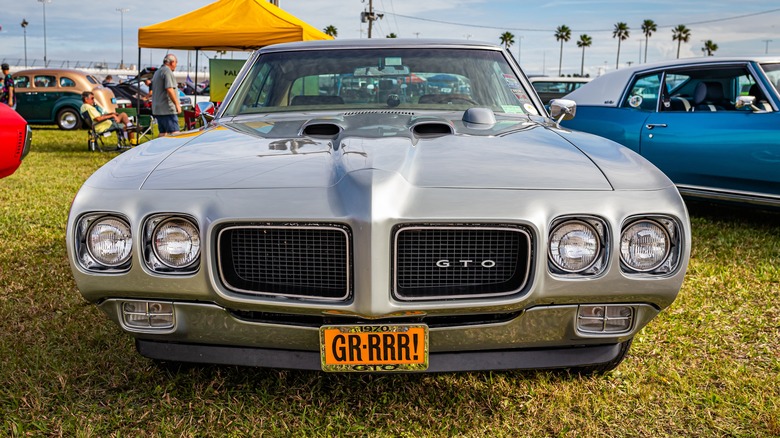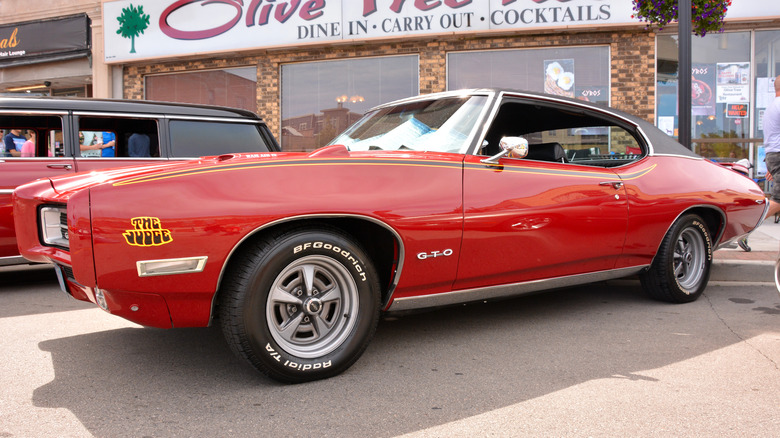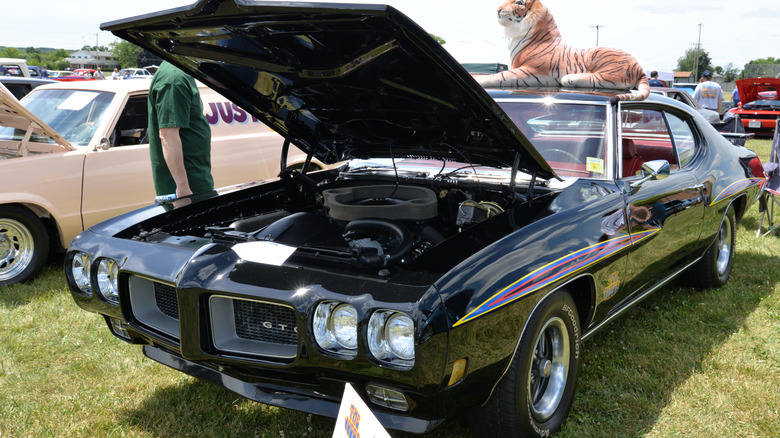What Made The 1970 Pontiac GTO A Legendary Part Of Muscle Car History
It's pretty much impossible to talk about muscle cars without talking about the Pontiac GTO. Pontiac is, after all, credited with birthing the American muscle car movement by sending the first of its iconic GTO builds to its showroom floors in 1964. Said movement promptly began to go mainstream once the accessible GTO hit the scene, with U.S. manufacturers spending the better part of the ensuing decade producing horsepower-hungry brutes for the American middle class.
By the end of the '60s, the GTO was regularly being challenged for muscle car supremacy by offerings from every other major U.S. automaker, not to mention vehicles from Pontiac's own stacked in-house lineup of muscled-up monsters. Embracing the challenges, Pontiac's design team set its sights on sending a GTO to market that was sure to reclaim the legendary build's rightful place atop the muscle car mountain. One could argue that the team did just that and then some with the 1970 model, which has come to be regarded by many muscle car enthusiasts as the GTO to end them all.
Even as Pontiac's groundbreaking '64 GTO had become a legend in its own time, the supremacy of the 1970 GTO was impossible to argue. So much so, that the blacktop-devouring vehicle is now seen as a legit automotive legend in its own right. Here's why the 1970 GTO is so revered in the annals of muscle car history.
The GTO's redesigned body was the definition of muscular
The 1970 Pontiac GTO's ascension to the ranks of muscle car legend began with a few notable modifications to its exterior design. To be clear, the '70 model didn't receive a complete facelift from the distinctive semi-fastback, twin-scooped hood look that helped the '69 build feel so imposing barreling down the road. However, in a move that gave the GTO more "Firebird-y" features, Pontiac squeezed in the vehicle's elongated front end a touch, while insetting and slightly rounding-off its iconic split grille. The manufacturer also squared the bezels of the headlights on each side, making them far more prominent in the front-end frame.
Pontiac further altered the body by flattening the vehicle's wheel guards, a seemingly innocuous move that somehow gave the '70 GTO a more combative vibe, as did adjustments to the front and rear fenders. While the 1970 build didn't veer too far in look from its immediate predecessor, the redesign left this GTO looking dramatically different from any of the noble GTOs that came before. All in all, the '70 GTOs general lack of rounded edges simultaneously made it look sleeker and more muscular, ensuring it would be intimidating to any vehicle that dared challenge it.
Of course, if you wanted to soften the GTO's power-hungry look, upgrading to the GTO's Judge trim package allowed buyers to outfit their vehicle in groovy colors and tri-color decals to boot. But even with the trippy upgrades, the 1970 GTO still fronted a formidable frame when it hit the open road, and one could argue that Pontiac never improved upon it.
The 1970 GTO also had the muscle where it mattered the most
Looks undoubtedly played a significant role in making the 1970 GTO such a memorable figure from the muscle car era. But let's be honest that even the toughest-looking car on the road can be laughed at by muscle car lovers if it doesn't flex where it really matters — under the hood.
As Pontiac arguably invented the muscle car with the OG GTO — and bolstered its skin in the game with additional offerings like the Firebird, Trans Am, and Grand Prix — the company was, perhaps, more aware of that fact than any of the major automakers building such vehicles. And yes, Pontiac bosses more than did right by the '70 GTO, offering drivers the chance to outfit the vehicle with a bevy of high-compression big-bore options. Among those options were Pontiac's standard 400-cubic inch V-8 engine, a 4.12-inch bore and 3.75-inch stroke monster that produced 350 horsepower and 445 lb-ft of torque.
Those looking for a power upgrade could opt for the Ram-Air IV V8, whose 370 horsepower ranks it among the most powerful engines in Pontiac history. However, the real game-changer for the '70 GTO was the availability of Pontiac's 455-cubic inch V8, which, despite it's horsepower being equal to the Ram-Air IV, pushed the torque up to a whopping 500 lb-ft, providing considerably more get-up-and-go. Realistically, whichever engine you opted for in the 1970 Pontiac GTO, you could be certain that the vehicle would more than hold its own on the road. Combined with its distinctive look, the '70 GTO remains one of the more legit legends from the muscle car movement.


